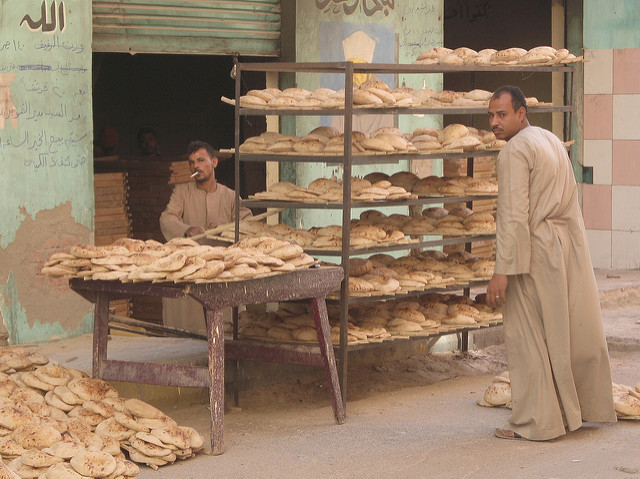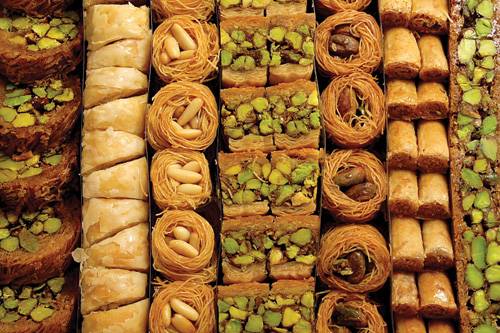
Introduction
Arab cuisine mostly follows one of three culinary traditions – from the Maghreb, the Levant or the Gulf.
-
In theMaghrebcountries (Morocco, Algeria, Tunisia and Libya) traditional main meals are tajines or dishes using couscous.
-
In theLevant( Palestine, Jordan, Lebanon and Syria) main meals usually start with mezze – small dishes of dips and other items which are eaten with bread. This is typically followed by skewers of grilled lamb or chicken.
-
Gulfcuisine, which has Iranian and Indian influences, tends to be more highly spiced with more use of rice. Sometimes a lamb is roasted and served whole.
In the Arab countries generally, lamb and chicken are the most popular types of meat, though goat, beef and occasionally camel meat are consumed too. Muslims usually avoid eating pork.
Fruit and vegetables
In comparison with western cuisine, Arab cuisine tends to make more use of lentils, chickpeas and numerous types of bean. Use of olives, aubergines, courgettes and okra is also more common.
Raw pickled vegetables are often served on a side dish. These may include chillis, gherkins, and slices of turnip, cucumber, carrot, etc.
Common fruits are citrus, dates, figs, grapes, pomegranates, melons, watermelons, apricots and prickly pears (cactus fruit).
Common nuts are almonds, peanuts, pine nuts, pistachios, and walnuts. Nuts may be included in main dishes as well as sweets and desserts.
Bread
Bread in the Arab countries is usually round and flat, though its size and thickness can vary a lot. Most countries have their own typical styles for everyday consumption.
Bread is a staple of most meals and in some situations is used in place of a spoon or fork for scooping up food.
Some types of bread are unleavened; others are made with yeast. A tasty example of unleavened bread is the Yemenimalawahand here is a recipe for aMoroccan yeast bread, orkhoubz.
Needless to say, bread in the Arab countries is usually baked in ovens (which can often be seen glowing red in the back of Arab bakers' shops) but it may also be baked by laying a very thin sheet of dough on to a heated (usually domed) surface.
A third and more interesting method is sand baking – a traditional technique in desert areas using the remains of a camp fire. The glowing embers are scraped away and a shallow hollow is made where the fire has been. The dough is placed in the hollow then covered with sand and the embers until it is baked.
Spices and flavours
Spices commonly used in Arab cuisine include (in alphabetical order): allspice, aniseed, caraway, cardamom, cinnamon, cloves, coriander, cumin, fenugreek, nutmeg, paprika, saffron, sesame,sumac, and turmeric.
Baharatis an all-purpose seasoning which contains black pepper plus, typically, cumin, cinnamon, and cloves. It may also contain coriander, cardamom, nutmeg and/or paprika.
Ra's el hanout(literally, "top of the shop") is a general-purpose spice mixture used for savoury dishes in North Africa. By tradition it contains 12 different spices. The combination varies from one maker to another but it is almost certain to include paprika, cumin, chili and cinnamon.
Za'ataris a widely-used condiment throughout the Middle East. It is a mixture of dried herbs – marjoram, thyme, oregano, etc – plus sesame seeds, sumac and salt. Again, there are differences of opinion about the best combination of ingredients and their proportions.Za'atarcan be used in general cooking – for example, rubbed over a chicken before roasting – and sprinkled on bread dough before baking (man'oushehin Lebanon). It can also be consumed without cooking, by dipping pieces of bread into olive oil and then intoza'atar.
Harissais a hot chili paste particularly associated with Tunisia, Libya and Algeria. It is also available dry, as a spice mix.
Michael Day." src="/sites/default/files/Spice_Market%2C_Marakech_%282242330035%29.jpg" style="border-style:solid; border-width:1px; height:291px; width:388px" />
Sweets and desserts
Kunafa(kanafeh / kunafah) has a crusty top made from noodle-like shreds of pastry, with a filling of soft white cheese. The whole dish is steeped in sugary syrup with a hint of rosewater is often decorated with a sprinkling of chopped pistachio nuts.Kunafais usually baked as a single piece on a large metal tray and then cut into slices. There are several variants, however, and it may also be found in the form of small, individual rolls. Here isa short videodemonstrating how to makekunafa.
Basbousais a very sweet and sticky cake made with semolina, and sometimes with the addition of coconut. It is usually topped with almonds. In Lebanon it is also known asnamouraand in Tunisia asqalb el-lawz("heart of the almond").
Baklawacomes in a variety of shapes and styles, cut into tiny pieces because it is very rich and sweet. The basic ingredients are filo pastry, chopped nuts and honey or sugar syrup. It is thought to have been introduced to the Arab countries by the Ottomans.
Mahalabiais a milk pudding, typically flavoured with cardamom and rosewater. It is served cold.
Umm Ali("the other of Ali") is richer thanmahalabiaand is served hot. Crumbled pieces of pre-baked filo pastry are mixed with hot milk, cream, sugar, raisins, chopped nuts and sometimes coconut. It is then browned under a grill.Recipe here.

Islam and food
Observant Muslims distinguish between food which ishalal(permitted andharam(forbidden). The basic rule is set out inVerse 2:173of the Qur'an which forbids consuming carrion, blood, "the flesh of swine" and meat from any animal which has not been slaughtered in the name of Allah (by uttering a short prayer as the animal's throat is cut).
Fish is consideredhalal, though some Muslims avoid certain types of seafood such as shellfish and crustaceans. Discussions can also be found on Islamic websites about the permissibility (or not) of eating other types of creature, such as crocodiles, snakes and frogs.
In 1997 the UN's Food and Agriculture Organisation issuedgeneral guidelinesabout which kinds of food can be labelled as "halal", though it noted that there are differences of opinion among religious scholars.
During the holy month of Ramadan, Muslims are expected to refrain from eating, drinking and smoking between sunrise and sunset. The evening meal that breaks the fast – known asiftar– is regarded as a special social or family occasion. Certain foods and dishes are traditionally associated with Ramadan andiftar, though these vary from country to country. One example is the sweet known asqatayef.
Regional recipes
Here are some general collections of online recipes from around the region:
Middle Eastern recipes
(saveur.com)
The 10 best Middle Eastern recipes
(The Guardian)
Middle Eastern recipes
(allrecipes.co.uk)
Turkish and Middle Eastern recipes
(BBC)
Middle Eastern recipes
(Epicurious)
Vegetarian Soups from the Middle East
by Habeeb Salloum
ALGERIA
Algerian recipes
A collection from Clifford Wright
EGYPT
Some Egyptian specialities:
-
Ful medamesis a traditional breakfast dish of fava beans with oil and cumin, stewed in a gigantic pot. It may also include lemon juice, onions, garlic or chili and is normally scooped up with pieces of bread.Recipe here.
-
Kushari(koshary / kosheri) is tasty, cheap and filling. It is regarded by many as Egypt's national dish. Usually served in a bowl, it consists of rice, lentils, macaroni and cumin topped with crispy fried onions and a tomato sauce.Recipe here.
-
Mulukhiyah(molokhia) is made from the leaves ofCorchorus olitorius, a type of jute. In appearance it resembles cooked spinach but has a glutinous – some would say slimy – consistency. It can be consumed on its own as a soup or served with a stew.
-
Pigeonsare considered a delicacy in Egypt. They may be grilled or stuffed and roasted.
100+ Egyptian recipes
(pinterest.com)
Recipes for food and cuisine from Egypt
(touregypt.net)
Egyptian recipes
(food.com)
Egyptian recipes
(allrecipes.com)
Delicious Food of Egypt
(foodofegypt.com)
Tasty vegetarian recipes from Egypt
by Marie Henein
IRAQ
The Iraqi Family Cookbook
A blog with more than 150 recipes
In my Iraqi Kitchen
A blog by Nawal Nasrallah about Iraqi food and its history, with recipes.
How about cooking Iraqi?
Four recipes from Lamees Ibrahim'sIraqi Cookbook
Iraqi recipes(food.com)
Iraqi recipes(pinterest.com)
JORDAN
-
Mansafis lamb cooked injameed, a sauce made from dried yogurt. It is eaten on special occasions in Jordan, typically served on a large platter with a bed of rice or bulgur. Mansaf, as known today, is a modern adaptation of a traditional (but rather different) bedouin dish. It is often described as Jordan's national dish – though that idea seems to be a fairlyrecent invention.
Mansaf recipe
by Clifford Wright
Mensaf – Jordanian lamb stew
(allrecipes.com)
Jordanian mansaf
(food.com)
LEBANON
Lebanese starters
(lebmania.com)
Lebanese salads
(lebmania.com)
Lebanese main dishes
(lebmania.com)
Lebanese sweets
(lebmania.com)
40 Lebanese recipes
(recipesource.com)
Miscellaneous recipes
Mainly Lebanese mezze dishes (almashriq)
LIBYA
Introduction to Libyan food
(temehu.com)
Libyan food
A large collection of recipes, with photographs
The Libyan Kitchen
A blog with recipes
Libyan recipes
(food.com)
MOROCCO
-
Atajine– usually consisting of meat and vegetables – is traditionally cooked over a charcoal fire in a shallow earthenware dish with a conical lid. The shape of the lid ensures that moisture does not drip directly on to the food but trickles down around the edges – which is said to improve the flavour. Somewhat unusually, tajine recipes may include some sweet fruit such as prunes or apricots.
Moroccan recipes
(recipesource.com)
Moroccan recipes
(epicurious.com)
14 Moroccan recipes
by Clifford Wright
PALESTINE
-
Maqluba("overturned") is a traditional dish of rice with lamb or chicken and a variety of vegetables. The ingredients are cooked together in a pan which is then turned upside down for serving – hence the name. Typically, the top two layers when the dish is turned out consist of sliced tomato and aubergine.
-
Musakhanis chicken roasted with onions, sumac, allspice, saffron and pine nuts, on a bed oftaboonbread.
A recipe for maqluba
by Clifford Wright
A recipe for musakhan
by Clifford Wright
Kitchen of Palestine
A large collection of recipes
Palestinian recipes
(food.com)
Palestine: recipes and cuisine
(whats4eats.com)
SAUDI ARABIA
Saudi Arabian recipes
(food.com)
Kabsa – traditional Saudi rice and chicken
(allrecipes.com)
Saudi Arabian meat dishes
(recipes.wikia.com)
-
Abrik– popular in Tunisia and Algeria – is a triangular envelope of thin fried pastry which usually contains a whole egg with chopped onion, tuna, harissa and parsley. It needs to be eaten with some care – otherwise egg yolk may squirt out. Here is avideo demonstrationof how to make a brik.
Tunisian recipes
(food.com)
Tunisian recipes
Background notes and a large collection of recipes (cookipedia)
Tunisian recipes
Soups, main courses, side dishes, cakes and biscuits (recipes4us)
Tunisian recipes and food
(sbs.com.au)
Recipes: Tunisia
by Clifford Wright
Vegetarian Tunisian recipes
(djebbana.tripod.com)
YEMEN
See al-bab'sspecial page


